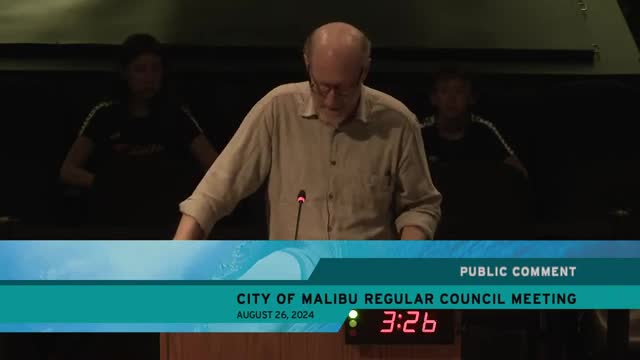Malibu faces critical evacuation challenges amid rising density
September 15, 2024 | Malibu City, Los Angeles County, California
This article was created by AI summarizing key points discussed. AI makes mistakes, so for full details and context, please refer to the video of the full meeting. Please report any errors so we can fix them. Report an error »

In the heart of Malibu, where the sun-kissed coastline meets the rugged hills, city officials gathered to address pressing concerns that echo through the community. The recent City Council meeting on August 26, 2024, revealed a tapestry of challenges facing this picturesque locale, particularly regarding traffic, emergency preparedness, and housing density.
One of the most significant issues raised was the city's traffic constraints. With Malibu's main road often congested, the potential for disaster looms large, especially in a region marked as a high fire hazard severity zone. A council member pointed out that the evacuation plan, while a step in the right direction, does little to alleviate the overwhelming number of vehicles on the road during emergencies. The haunting memory of the Woolsey Fire, where cars were trapped for hours on Pacific Coast Highway (PCH), served as a stark reminder of the risks involved. The council member emphasized the need for better communication with state agencies, particularly the Department of Housing and Community Development (HCD), to ensure they understand Malibu's unique challenges.
The conversation also touched on the implications of increasing housing density. With proposals allowing up to three residences per parcel, concerns were raised about how this could heighten the risk of dangerous situations during evacuations. The narrow access routes in canyon neighborhoods were highlighted as particularly vulnerable, underscoring the need for a more nuanced approach to development that considers safety alongside growth.
Moreover, the council discussed the importance of showcasing Malibu's role as a major tourist destination, attracting 16 million visitors annually. Despite this, officials noted that outside agencies often overlook Malibu's visitor-serving capabilities, which could impact decisions related to short-term rentals and campground regulations.
As the meeting progressed, the council also questioned Caltrans' plans to replace a crucial lane on PCH with a landscaped median, a move that could hinder emergency access on busy beach days. The need for a comprehensive understanding of Malibu's unique geography and infrastructure was clear, as officials called for a more robust dialogue with state agencies to advocate for the city's needs.
In conclusion, the discussions at the City Council meeting painted a vivid picture of a community grappling with the balance between growth and safety. As Malibu continues to navigate these challenges, the call for better communication and understanding with external agencies remains paramount, ensuring that the city's unique attributes are recognized and prioritized in future planning efforts.
One of the most significant issues raised was the city's traffic constraints. With Malibu's main road often congested, the potential for disaster looms large, especially in a region marked as a high fire hazard severity zone. A council member pointed out that the evacuation plan, while a step in the right direction, does little to alleviate the overwhelming number of vehicles on the road during emergencies. The haunting memory of the Woolsey Fire, where cars were trapped for hours on Pacific Coast Highway (PCH), served as a stark reminder of the risks involved. The council member emphasized the need for better communication with state agencies, particularly the Department of Housing and Community Development (HCD), to ensure they understand Malibu's unique challenges.
The conversation also touched on the implications of increasing housing density. With proposals allowing up to three residences per parcel, concerns were raised about how this could heighten the risk of dangerous situations during evacuations. The narrow access routes in canyon neighborhoods were highlighted as particularly vulnerable, underscoring the need for a more nuanced approach to development that considers safety alongside growth.
Moreover, the council discussed the importance of showcasing Malibu's role as a major tourist destination, attracting 16 million visitors annually. Despite this, officials noted that outside agencies often overlook Malibu's visitor-serving capabilities, which could impact decisions related to short-term rentals and campground regulations.
As the meeting progressed, the council also questioned Caltrans' plans to replace a crucial lane on PCH with a landscaped median, a move that could hinder emergency access on busy beach days. The need for a comprehensive understanding of Malibu's unique geography and infrastructure was clear, as officials called for a more robust dialogue with state agencies to advocate for the city's needs.
In conclusion, the discussions at the City Council meeting painted a vivid picture of a community grappling with the balance between growth and safety. As Malibu continues to navigate these challenges, the call for better communication and understanding with external agencies remains paramount, ensuring that the city's unique attributes are recognized and prioritized in future planning efforts.
View full meeting
This article is based on a recent meeting—watch the full video and explore the complete transcript for deeper insights into the discussion.
View full meeting
